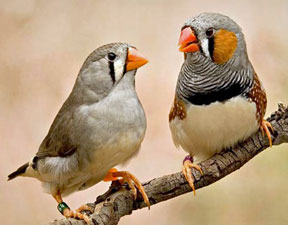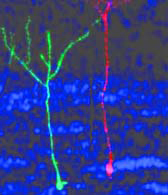|
The easy topic first: After a man-year of intense work, my fearless editor and I have indexed Feynman Simplified.
Each section in all 11 volumes is now numbered, and every important
topic is indexed alphabetically, showing the section numbers in which
they are explored.
For example, if you are interested in
conservation laws, the index lists ten sections that cover every
facet of these principles. Want to know what benzene and the Mona Lisa
have in common? The index says see 3B §21.8.
Download your free index.
Now what was our next topic? Oh, yes:
memory. How do we remember facts, names, phone numbers, songs, and how
to say our own names? Speech is perhaps the most difficult of all fine
motor skills.

I went to this year’s Caltech Alumni
Seminar Day eager to hear a talk on neutrinos, and was annoyed when I
found that it was cancelled. So instead, I went to a talk on how zebra
finches learn to sing, by Professor Carlos Lois, who recently joined
Caltech from the University of Valencia in Spain.
It turns out, Lois’s talk was more fascinating than neutrinos.
Really, this is all about romance. Male
zebra finches have an elaborate song, and if they sing perfectly, they
procreate. Poor singers are out of luck and have no chicks.
Successful dads teach their offspring
the song of their lives. While male chicks learn to sing, female chicks
may be learning to recognize a bird with the right stuff. It takes 90
days, and all of one million repetitions, for a male chick to learn the
song. Imagine practicing something one million times! It's amazing what
we'll do for love.
Lois explained that only five animal
species are capable of complex vocalization: humans, apes, dolphins,
whales, and songbirds. Other animals make simple sounds — grunts and
shrieks — but cannot form articulated sounds.
Understanding how zebra finches learn to sing provides insights in how memory works, and what goes wrong when it doesn’t.
Lois uses an amazing new technology —
nonlinear two-photon fluorescent microscopy — to peer non-invasively
through the feathers and skull of a singing bird and image individual
neurons in their brain. No need to open the skull or any other surgery.
Check out this image of two neurons from Professor Lois’ website:

Lois watches in real time as neurons
fire in the precise sequence required to activate the right note at
exactly the right time. And as a chick learns, Lois watches the gradual
formation of the neural network that defines The Song.
Here is the score of “All I Need Is Love” finch-style.

I tried whistling to my editor, but I must be doing it wrong.
Best Regards,
Robert
July 20, 2016
Note: Previous newsletters can be found on my website.
|